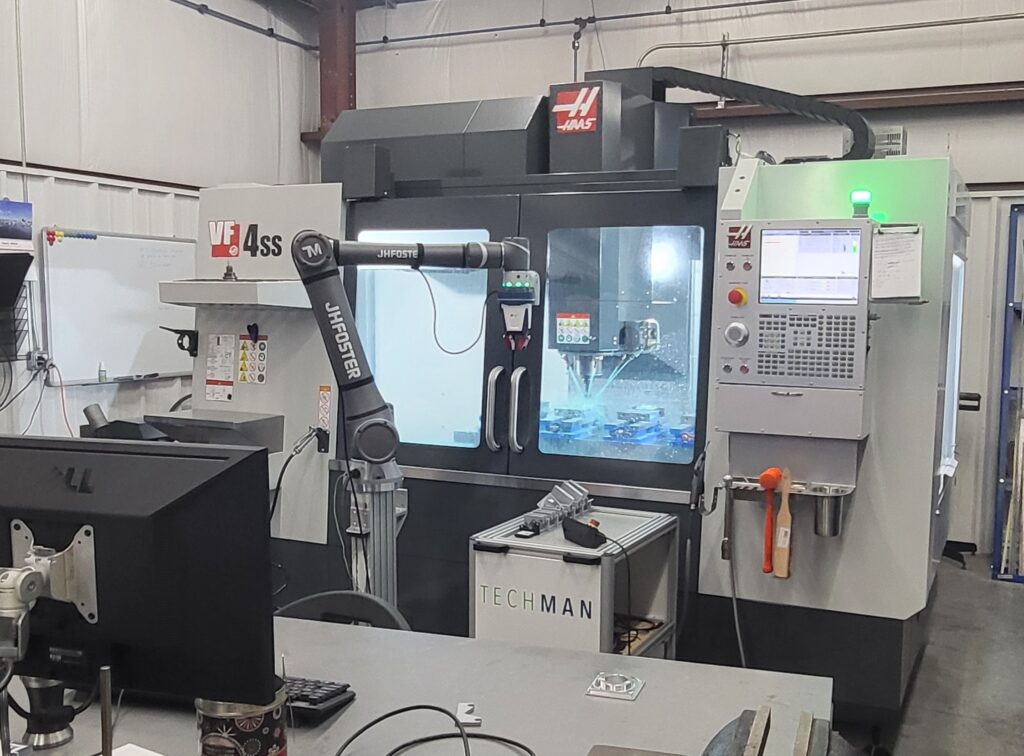8 Steps for Integrating Automated CNC Machine Tending into Workflows
CNC machine shops are an integral part of the manufacturing industry, but they are under pressure to reduce cycle times and increase productivity without increasing costs. Automation of CNC machines – particularly CNC machine tending – is a cost-effective way to increase efficiency as automation and machine tending robots allow CNC machine shops to maximize productivity despite a shortage of skilled CNC machine operators. This blog will discuss the benefits of automating CNC machine tending applications and provide eight steps for successful automation integration.

What is Machine Tending?
Generally speaking, machine tending is the process of loading raw materials or parts to a machine, unloading the finished product upon completion of the cycle and then restarting the process over again. Specific to CNC machine operators, manually managing machine tending activities is physically demanding, repetitive and time consuming, which can result in workplace injuries, boredom and bottlenecks that create inefficiencies.
Automating the workflow by using a machine tending robot to place a raw part into the machine and remove it once the process is complete can increase safety, maximize throughput and quality and minimize costs as machine tending robots can handle the repetitive motions without injury, do not become fatigued and manage the tasks at higher speeds and with greater consistency.
While the increased efficiency is an obvious win, there are other advantages of automated CNC machine tending, including:
- Increased uptime: Because machine tending robots can operate 24/7 without breaks or shift changes, they can continuously feed materials into the machine without stopping, which increases the overall equipment effectiveness and uptime of the CNC machine shop.
- Maximized quality: When CNC machine operators perform machine tending tasks manually, there are likely to be more errors as they grow tired or bored. Using a machine tending robot to load and unload parts from the machine ensures consistent loading without errors. This will increase the accuracy of the process and increase quality.
- Safer operations: As machine tending is physically demanding work, it often leads to repetitive motion injuries among CNC machine operators. By reassigning skilled workers to more value-added and complex tasks in the facility and using automated machine tending, repetitive motion injuries will be reduced. Also, human employees will not be exposed to moving machinery parts, further reducing safety risks.
8 Steps for Integrating Automated CNC Machine Tending into Workflows
To reap these benefits, automated machine tending can be integrated into a variety of CNC machines, including CNC lathes, CNC milling machines and CNC laser cutters.
While each installation will differ depending on the operation, most automated CNC machine tending cells, include the following components:
| Machine tending robot | A robot or cobot that can handle the payload and manage the reach needed for the workspace should be equipped with the proper end of arm tooling for the job. |
| Mounting configuration | The machine tending robot should be mounted in the work cell and properly located. |
| The CNC machine | This can be any machinery typically used in a CNC machine shop, such as a lathe or mill. |
| Staging tables or conveyors | At the infeed, staging tables and conveyors are used to hold unfinished parts waiting to be loaded. They are also needed at the outfeed to hold finished parts or move them away from the process. |
| The controller | This is used to control the machine tending robot. |
When done properly, integrating this type of automation into a CNC machine shop workflow can provide a cost-effective way to make your business significantly more efficient, productive and competitive.
Here are eight steps for successful automation integration:
Select the proper machine tending robot
Collaborative robots are a popular choice as they can safely operate around CNC machine operators that may share the workspace and they can be more easily reprogrammed to accommodate changing parts or workflows. However, for heavier parts, an industrial robot arm may be a better choice. Either way, ensure that the selected robot can handle the payload and provide the required reach for the task.
Consider the mounting configuration
The mounting configuration can impact the productivity of the cell, so be sure to consider whether a stand, a cart, ceiling mount or direct machine integration provides the optimal solution for the part type, work cell size and the way the machine tending robot will maneuver within the space.
Evaluate the tasks
Look at the workflow within the operation and determine what activities the machine tending robot will be required to perform, the necessary steps (for example: picking up a raw part, opening doors, moving the part inside the machine, placing the part into a vise, removing the finished part from the machine, placing the finished part on the outfeed tray) and how the robot can be programmed to perform these steps.
Select appropriate tooling
The chosen end effector must match the part size and material in order to provide the best efficiency and performance when picking up and placing unfinished and finished parts.
Consider automated vises
Most CNC machines are equipped with manual vises, but integrating an automated vise will help further increase productivity and precision and may be operated by the robot as part of the program.
Automate the CNC doors
For greater efficiency, automated CNC doors can be programmed to open and close upon receiving a signal from the machine tending robot, although there are ways to program robots to manually open and close the doors.
Determine how the robot will communicate
Because machine tending robots need to perform several functions, determine whether pushing buttons to activate vises, start the process and open and close doors is a suitable solution or whether it is best to have the robot send signals to the control system to initiate these tasks. Automation integration with the control system is more complex, but more efficient. However, non-invasive integration button-pushing options are also available.
Select a part feeding solution
Tables and conveyors are popular choices, but the best and most cost-effective solution will depend on your current operation. Typically, smaller operations can use tables for both finished and unfinished parts. Larger, more complex operations may want to consider infeed and outfeed conveyors to further increase efficiency and reduce bottlenecks.
When properly integrated into the CNC machine shop workflow, machine tending robots can significantly increase the efficiency, productivity and quality of the operation, helping to maximize safety, quality and profitability. To learn more about automated CNC machine tending and machine integration, please contact JHFOSTER, a Tavoron company, today.
